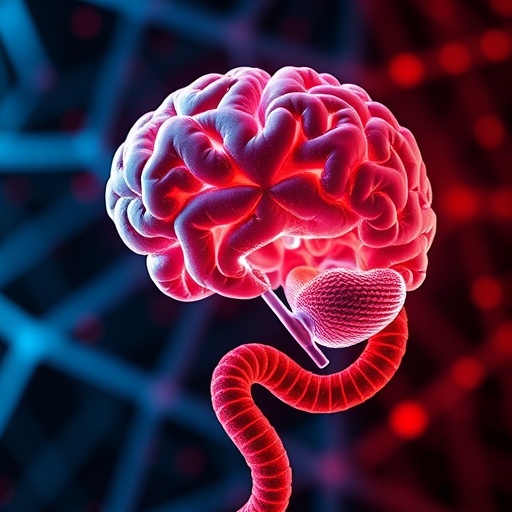In an era where environmental pollutants increasingly intersect with human health, recent research has unveiled a startling connection between nanoplastics and the progression of Parkinson’s disease (PD). A groundbreaking study published in npj Parkinson’s Disease brings to the forefront the metabolic consequences of nanoplastic exposure, particularly how it exacerbates neurodegenerative pathology through digestive tract dysfunction. This work not only challenges existing paradigms about PD onset and progression but also shines a critical light on the often-overlooked gastrointestinal system as a central player in neurodegeneration.
Parkinson’s disease, a progressively debilitating disorder characterized by motor dysfunction and cognitive decline, has traditionally been associated with the degeneration of dopaminergic neurons in the substantia nigra. However, emerging evidence increasingly implicates peripheral systems—especially the gut—as early sites of disease manifestation. Intriguingly, the new study by Liang, Wang, Andrikopoulos, and colleagues elucidates how the dysfunction of the digestive tract might create a metabolic environment that amplifies the toxic effects of nanoplastics. This creates a biological feedback loop that accelerates Parkinsonian pathology.
Nanoplastics, tiny plastic particles less than 100 nanometers in size, are pervasive pollutants arising from the degradation of larger plastic waste. Their minuscule scale allows them to penetrate biological barriers and interact with cellular machinery, causing oxidative stress and inflammatory responses. The research explored how these nanoplastics accumulate within the gastrointestinal tract, disrupting normal metabolic processes and triggering a cascade of events that impact both peripheral and central nervous systems.
By utilizing advanced metabolomic profiling and histopathological analyses, the team identified significant metabolic alterations in the digestive systems of experimental models subjected to nanoplastic exposure. These metabolic disruptions included perturbations in key nutrient absorption pathways and mitochondrial energetics, culminating in compromised gut barrier integrity. The compromised barrier function facilitates translocation of nanoplastics and inflammatory mediators into systemic circulation, serving as a conduit for neuroinflammatory signaling.
A particularly striking finding was the alteration of short-chain fatty acid (SCFA) profiles, metabolites produced by gut microbiota essential for maintaining neuronal health. The imbalance of SCFAs under nanoplastic stress reflects a dysbiotic state within the microbiome, further exacerbating oxidative stress and neuroinflammation. This microbiome–gut–brain axis dysfunction is posited as a vital mechanism linking environmental toxin exposure to neurodegeneration.
Parallel to gut changes, the study reported marked enhancements in α-synuclein aggregation within enteric neurons, a pathological hallmark of PD. α-Synuclein, a presynaptic protein prone to misfolding and aggregation, forms Lewy bodies that disrupt cellular function. Nanoplastic-induced metabolic stress accelerates these aggregative processes, highlighting a critical intersection where environmental factors converge with genetic and proteinopathy aspects of PD.
The researchers further identified mitochondrial dysfunction within enterocytes and neurons as a central metabolic hallmark. Mitochondria, the energy powerhouses of cells, are sensitive to oxidative stress and damage and are pivotal in PD pathogenesis. The study revealed diminished respiratory chain complex activities, increased reactive oxygen species (ROS) production, and disrupted mitochondrial biogenesis in subjects exposed to nanoplastics, painting a comprehensive picture of metabolic derangement.
A notable methodological strength of this work was the integrated use of multi-omics approaches, combining metabolomics, proteomics, and transcriptomics, to generate a holistic view of the metabolic landscape altered by nanoplastics. This allowed the identification of novel biomarkers linked to gastrointestinal dysfunction and PD progression, providing potential therapeutic targets for early intervention.
Importantly, the study also explored the systemic implications of nanoplastic-induced digestive dysregulation. Increased permeability of the gut lining corresponded with heightened peripheral immune activation and infiltration of inflammatory cells into the central nervous system (CNS). This immune crosstalk underscores the importance of gut integrity in maintaining neuroimmune homeostasis and mitigating PD risk.
Furthermore, longitudinal observations within the experimental framework revealed that chronic exposure to nanoplastics instigated a progressive cascade of metabolic and neuropathological changes, mirroring the slow and multifactorial nature of PD in humans. This temporal dimension adds a crucial understanding of how environmental pollutants might accelerate disease onset and severity over time.
What sets this study apart is its comprehensive characterization of nanoplastic toxicity beyond traditional neurocentric models. By positioning the digestive tract as a critical metabolic and immunological interface susceptible to environmental insult, it opens new avenues for PD research that marry environmental science with neurobiology. This approach underscores the imperative for interdisciplinary research in tackling complex diseases.
Another significant implication lies in public health policy. The pervasive presence of nanoplastics in the environment demands urgent attention to their potential neurotoxic effects. Regulatory frameworks for plastic waste and pollution must now consider the insidious long-term consequences on neurodegenerative diseases, prompting calls for stricter controls and enhanced biomonitoring.
In summary, this pioneering research redefines the narrative around Parkinson’s disease by highlighting how nanoplastic pollution triggers digestive tract dysfunction that underscores the metabolic hallmarks of neurodegeneration. The findings emphasize that safeguarding gastrointestinal health and curbing environmental nanoplastic contamination could emerge as vital strategies in stemming the tide of Parkinson’s and possibly other neurodegenerative disorders.
As global exposure to nanoplastics is nearly unavoidable, the urgency for further exploration into mitigating their biological impact escalates. Therapeutic development might leverage antioxidant strategies, microbiome modulation, and enhancement of gut barrier function to counter nanoplastic-induced metabolic stress. In parallel, public awareness campaigns geared toward reducing plastic usage and environmental contamination are crucial to translating scientific findings into societal benefit.
This transformative study stands as a testament to the complexity of Parkinson’s disease etiology and the hidden role of environmental factors in shaping metabolic and neuroimmune landscapes. It serves as a clarion call for the scientific community and policymakers alike to grapple urgently with the ubiquitous and unseen threat posed by nanoplastics within the human body.
Subject of Research: Dysfunctional digestive tract and its metabolic influence on nanoplastic-exacerbated Parkinson’s pathology.
Article Title: Dysfunctional digestive tract highlights the metabolic hallmarks of nanoplastic-exacerbated Parkinson’s pathology.
Article References:
Liang, X., Wang, Y., Andrikopoulos, N. et al. Dysfunctional digestive tract highlights the metabolic hallmarks of nanoplastic-exacerbated Parkinson’s pathology. npj Parkinsons Dis. 11, 300 (2025). https://doi.org/10.1038/s41531-025-01145-2
Image Credits: AI Generated




